“As far as the laws of mathematics refer to reality, they are not certain; and as far as they are certain, they do not refer to reality.” -Albert Einstein
It's been a fabulous, fun-filled week over at the main Starts With A Bang blog, and we've taken on a variety of topics that range from the small and subtle to the large and... less subtle. In a span of only seven days, we've explored the following topics and questions (and go ahead and click if you missed anything):
- What is a quantum observation? (for Ask Ethan),
- But will it Bea Art(hur)? (for our Weekend Diversion),
- The Most Perfect Elliptical, M89 (for Messier Monday),
- What happens when the largest objects meet their twins?,
- Is our Universe left-handed?, and
- The truth about solar storms.
As always, we've set up synopses here and given you the opportunity to comment and interact with one another and with me. So let's dive in to your Comments of the Week!
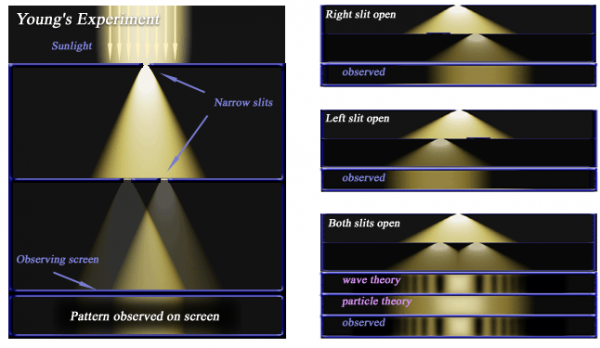 Image credit: the HOW and WHY — Behind Reality — via http://www.thehowandwhy.com/doubleslit.html.
Image credit: the HOW and WHY — Behind Reality — via http://www.thehowandwhy.com/doubleslit.html.
From eric on the topic of quantum observations: "[I]t typically is only a matter of time until an “observer” particle comes along. But you should look up the delayed choice quantum eraser concept. If you destroy all information gained from the interacting “observer” particle – even long after the interaction has occurred – the state of the system in the past goes back to indetermina[te]/wave-like."
You have to be careful with experiments like the "delayed choice quantum eraser" one, because it isn't the same as a single high-energy interaction. If I shone a high-energy photon on an electron going through a double slit as it went through one slit or the other, I'd destroy the interference pattern whether I looked or not.
The delayed-choice quantum eraser concept is a little more subtle.
What you have to imagine is that you have two entangled particles -- photons, for example -- that are in an indeterminate state of some type. You can separate them, measure/determine the (polarization) properties of one and "determine" the properties of the other.
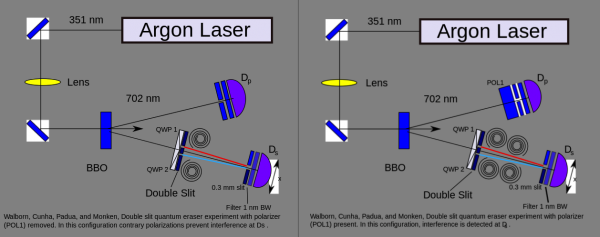 Images credit: original schematics via Walborn, Cunha, Pádua, and Monken; via Wikimedia Commons user Patrick Edwin Moran.
Images credit: original schematics via Walborn, Cunha, Pádua, and Monken; via Wikimedia Commons user Patrick Edwin Moran.
If you measure the polarization of one photon, you determine it on the other one; that's the left-hand diagram. But if you throw in, say, a diagonal polarizer (to add back a mixture of polarizations), you can restore the interference pattern in the other photon. That's how a quantum eraser works, and variants that delay that choice have been verified: that interference pattern will appear or disappear if you do the determining even after the measurements have been made.
But make no mistake, it's still about having an interaction of sufficient strength and quality to determine the outcome of a system. The only "oddness" is that if you determine the outcome of one system that's entangled with another, you also determine the outcome of the other system instantaneously. In other words, quantum "determinism" is a non-local phenomenon.
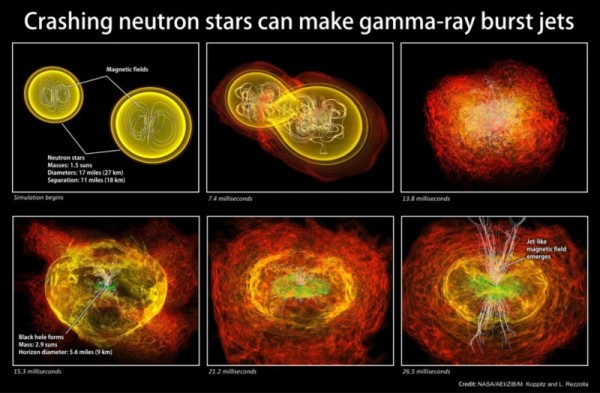 Image credit: NASA / Albert Einstein Institute / Zuse Institute Berlin / M. Koppitz and L. Rezzolla.
Image credit: NASA / Albert Einstein Institute / Zuse Institute Berlin / M. Koppitz and L. Rezzolla.
From jt on the topic of the largest objects meeting their twins: "I’ve read a few other things about neutron star mergers and how they produce very heavy elements, [e.g.,] gold. As I understand it, a neutron star is basically made up of, well, neutrons that are stabilized by the intense gravity and surrounded by a thin shell of iron. So with very few protons around how does the formation of gold, etc happen?"
Well, I very much hope that one of the articles you read about neutron star mergers was this one that I wrote! (Because I can at least vouch that it's correct.) First, I want you to imagine how a neutron star formed: from the collapse of a core of a supermassive star! Although fusion typically can't get you up past iron/nickel/cobalt, as it isn't energetically favorable, the atoms themselves cannot stand up against the relentless collapsing pressure of gravitation. As a result, they collapse down into a much denser, more stable set of matter: a giant atomic nucleus that's electrically neutral, hence, a neutron star.
It would love to collapse down to a black hole, but the Pauli exclusion principle -- because every quark in there is a fermion -- is still strong enough to prevent that mass from collapsing further. You'd need to get a neutron star mass of around 3 solar masses to get enough gravity together in one place to make that collapse possible.
But what is it that happens, then, when two of these objects merge?
The vast majority of their mass will collapse down into a black hole, but about 0.1% of the initial system's mass will get ejected from the energy of the collision. When there's an energy release, you all-of-a-sudden can overcome energy barriers, and will spontaneously settle into (on average) more stable energy states. In terms of atomic nuclei, where will that put you?
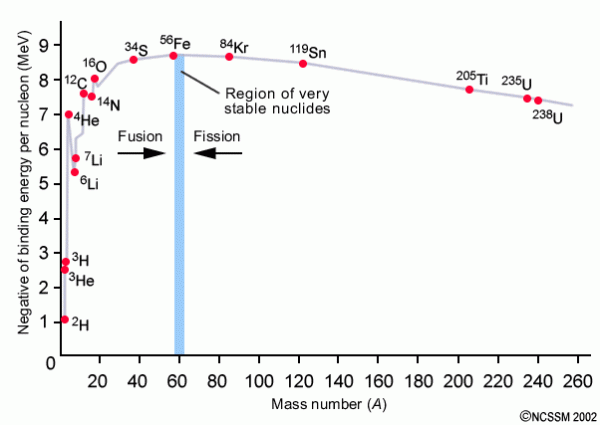 Image credit: North Carolina School of Science and Mathematics, via http://www.dlt.ncssm.edu/tiger/chem2.htm.
Image credit: North Carolina School of Science and Mathematics, via http://www.dlt.ncssm.edu/tiger/chem2.htm.
Although it would be very clean to say "back at iron," that's not accurate. Instead, it's better to say "back towards iron," from an incredibly large mass of neutrons. So yes, you'll create things like gold, platinum, radon, and lead, but you'll also create not only elements like bismuth and uranium, but trans-uranic elements like plutonium, curium and einsteinium, as well as elements that we probably have not yet discovered!
However, the vast majority of these elements decay incredibly rapidly; there is not a single atom of anything heavier than plutonium left over from the formation of our Solar System. Instead, our elemental abundance looks like this.
Do you notice how there's more lead (Pb) than anything else nearby? That's got a lot to do with all the heavier elements that we created decaying down in a chain that terminates with lead. So we don't need protons; we just need the neutron star to break up and then undergo (incredibly rapid) nuclear decays -- mostly Beta decay -- until it arrives at a quasi-stable configuration. Some of these configurations will be the heavier pre-lead elements in the periodic table (like tungsten, gold, mercury, etc.), while others will be heavier-than-lead elements which will then conventionally decay down to lead. And that's the story of the heavy elements from neutron stars!
From Sierra Nevada on the question of the Universe being left-handed: "How is the dipole of the rotation axis identified? Angular momentum can only be said to have a “handedness” if the axis of rotation some kind of “up” or “down” dipole. How can we tell which way is up in the axis of a spinning galaxy?"
This is, of course, a convention only. From our point of view, we call a galaxy whose arms radiate outwards in a counterclockwise fashion "right-handed" and one whose arms radiate outwards in a clockwise fashion "left-handed". We also talk about handedness having either a monopole or a dipole term, meaning that either:
- Monopole: there is a left/right-handedness asymmetry overall, which would correspond to there being more of one orientation of galaxy regardless of what direction we looked in. This would correspond to a particular orientation centered on-or-near us.
- Dipole: there is a preponderance of left-handed galaxies in one direction and an equal-and-opposite preponderance of right-handed galaxies in the other. This would correspond to a preferred axis of rotation for galaxies in the Universe, as indicated by figure (a) below.
Image credit: Michael J. Longo, 2011, via http://arxiv.org/abs/1104.2815.
When we talk about things as being "left-handed" or "clockwise" or something to that effect, we're talking about a naming convention and nothing more. Our Solar System, for instance, we say is "right-handed" or "counterclockwise," but that's only true if we consider it as viewed from the north pole; viewing it from the south pole makes everything appear left-handed or clockwise. If it was unclear the first time, I hope this helps clarify.
From Anon Amust on solar storms: "Particles are not ‘bent’, they are deflected. Sloppy language for a science based article."
There is an important distinction between bending and deflection when it comes to materials science: the "bending moment" is the measure of something like a beam's internal stresses; it's the thing that allows it to carry a load. Deflection, on the other hand, talks about the physical displacement of that beam under a load.
However, this particular example talks about how the path of a charged particle changes in the presence of a magnetic field, and the two words are interchangeable here. Thanks for the unnecessary and unfounded insult, though; we all know that people who write on the internet don't get enough of them!
And finally, from Hank Roberts on that same topic: "I think you may be either missing the point of some of concerns, or setting up a straw man argument. The concern (at least as expressed by more responsible sources) isn’t that anyone is facing direct, personal danger for a CME but rather that the resulting infrastructure damage (GPS, power grid, air traffic control systems, mission critical electronics in utilities, hospitals, manufacturing, etc.) would be a massive blow to the world economy, and people would suffer from the secondary and tertiary impacts of this."
Wow, I must have been really unclear in the article I wrote; I thought I was very straightforward in talking about that the major set of damage would be done to electronics and electrical equipment, and in how harmless it would be to humans directly. In 1989, for instance, we got a taste of this when we got hit by an X20-class solar flare. (By comparison, the Carrington event of 1859 was at least an X40-class flare!)
The dangers to humans will be from electrical fires, no doubt, but the longer-term danger will be from disrupted and destroyed infrastructure, as Hank correctly asserts. When scientists talk about the need to upgrade the power grid, the concern isn't only that we'll experience a blackout, the major concern is that the current grid will be rendered completely useless! The danger is not to us directly -- as the 1859 Carrington event killed nobody directly -- but through our electronics. Remember that the flare scale is linear-logarithmic, so an X20 flare is 20 times as powerful as an X1 flare, but an X1 flare is 10 times as powerful as an M1 flare. The strongest one we've ever measured directly (so, that's occurred in the past 25 years or so) is an X28 flare, but somewhere between X40 and X60, if it occurs and is directed at us, could cause the catastrophe we've been talking about.
Thanks for a very good week, and let's have an even better one coming up!
- Log in to post comments

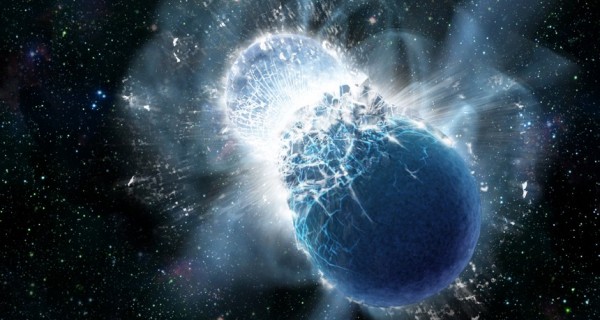
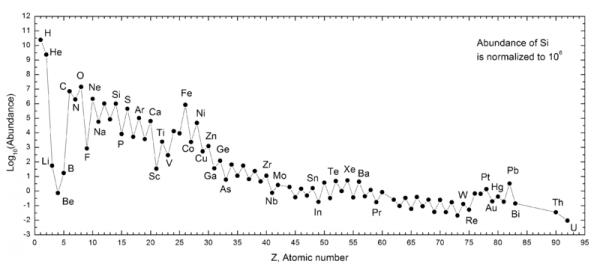
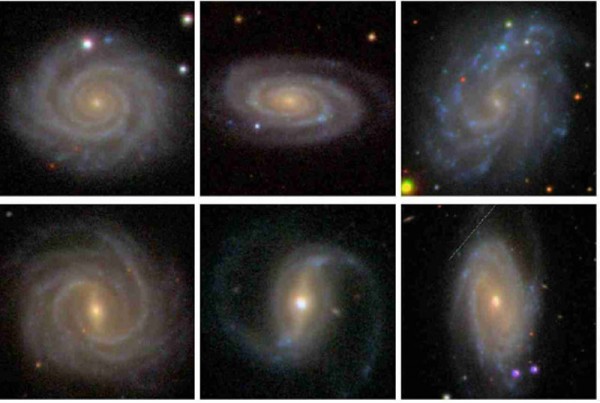
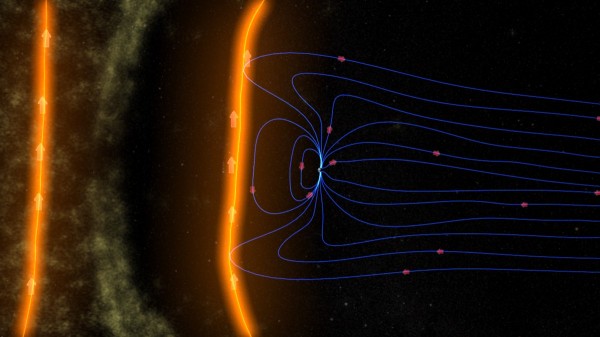
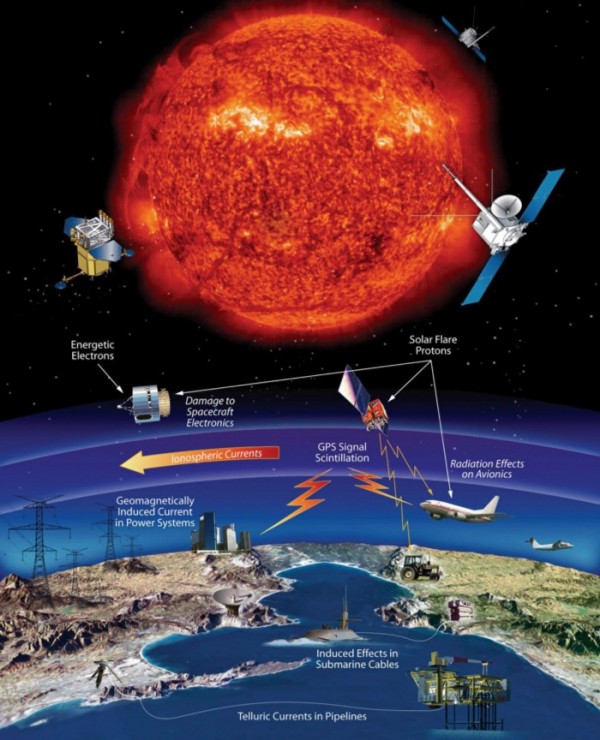
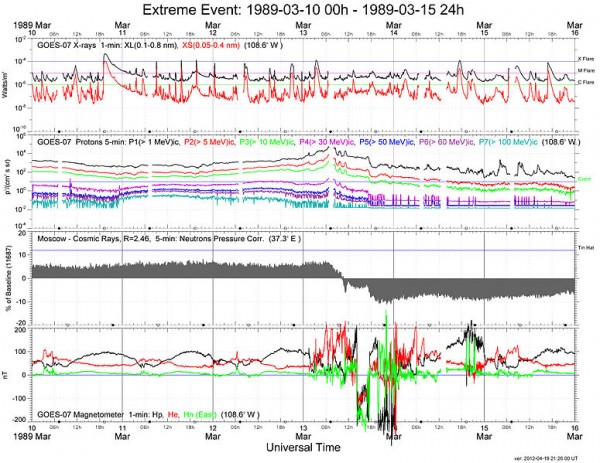
Thanks for the comment mention, Ethan. And as always, thanks for the excellent writing!
But! (There's always a But, and it looks like I'm it)
I still think that you do some of your readers a disservice in using "handedness" in this way. I understand the use of handedness as a shorthand to explain the relative rotation orientations.
What I took issue with is that by using it this way, readers can come away misinformed about what handedness is. These galaxies don't actually have a handedness, and readers might conclude, incorrectly, that handedness or chirality doesn't really denote something real.
It is true that "left handed" and "right handed" are arbitrary conventions. But that doesn't mean that chirality itself isn't a fundamental property of geometric objects in spaces like ours. For example, we assign a positive and negative charge by arbitrary convention as well, but that doesn't mean that charge doesn't exist. Chirality in various spaces is a fascinating subject all in itself, and I hope your readers look into it.
For instance, did you know that even though all 3d euclidian objects that have a plane of symmetry are not chiral (don't have a "handedness"), that there exist objects that lack a plane of symmetry that are also not chiral? Cool stuff!
Anyhoo, sorry to be a tempest in your teapot, and thanks again for the great blog.
I think the issue of quantum measurement is a little more complex than you suggest Ethan. In your first post on this you state regarding measurement:
"It has nothing to do with you or the “act of observing,” and instead everything to do with whether you interact with sufficient energy to “make an observation""
The delayed quantum erasure measurement of Kim et al (2000) is a useful one to look at. In this experiment one detector measures a "signal" photon - and one of four detectors measures an entangled "idler" photon. All the detectors are the same and the "energy" with with the "observation" is made is the same in all cases. However, due to the nature of the set up only detections at two of the idler detectors carry information that reveals which slit the original photon passed through - the other two detect the idler photon, but provide no information on which slit the signal photon passed through.
When you look at entangled photons that had the idler give information about which slit the signal photon went through, then the interference pattern is absent, when you look at signal photons whose entangled idler gave no information on which slit the signal photon went through, then the interference pattern emerges.
So, what matters here is not the "energy" of any interaction - it is all about information. If information is extarcted by a measurement that fixes the slit a photon (or electron) passes through, then the interference pattern can not be observed, if knowledge of which slit the photon passed through is absent, then the interference pattern is present.
Seriously non-local and very wierd stuff quantum entanglement and measurement.
@ Waterbergs
I would disagree with you on "So, what matters here is not the “energy” of any interaction – it is all about information."
Because in the case of quantum eraser that you mention, the energy is in the half silver screen in the eraser section. Or in other words... in order for the half-mirror to reflect a photon, that photon interacts with a silver atom in the glass. And if we want to get picky.. silver with absorb the original photon and re-emit a new photon with same energy etc.. That's the energy. That's the observation. Information comes much later when you actually ask a question, is a photon at this detector or that one... and you get yes or no.
*sorry.. not "...silver with absorb"... but "will absorb"
@ Sinisa
I'm afraid I would disagree with you on this. The "energy" issue, such as it is, and the observation lies in the detectors, not the mirrors. Only the correlation information extracted from the detectors enables the interference pattern to emerge. The mirrors are not detecting anything, but simply redirecting the photons. You can add any number of additional mirrors and bounce photons around - wont make any difference, as long as they end up at the required detectors.
With regards to the detectors my point was that in all cases the energy of the photon is absorbed and converted to an electrical signal - but only in the case where the path to the detector reveals conclusively which slit the photon travelled through is an interference pattern extracted via comparison of the co-incidence data from the two relevant detectors. The information is key, not the energy of any particular interaction involved.
@ Sinisa
None of the models I ever studied for reflection of photons from metallic surfaces like silver involve absorption and re-emission. Some photons are absorbed, but there aren't re-emitted in phase, like reflected photons are.
@ Waterbergs
"The “energy” issue, such as it is, and the observation lies in the detectors, not the mirrors. "
No, you are very wrong. Observation lies in the detectors, for us, for a person in a lab who can't see the photon until interacts with the detector. But remember, any quantum interaction is an effective observation. From point of view of photon, it will either interact with the half mirror or not. If it does interact (gets reflected), that's an observation from QM standpoint. Not your observation, but photon's.
And yes, you are correct, regular mirrors won't change anything, but you are not being careful. Half mirrors will change everything. It's the half mirror that brings back the interferance pattern. Because there is randomness in weather half mirror will reflect the photon or pass it through. The half mirror is acting as another double slit.
As for detectors... you chould check how detectors actually work.. how they create a signal... and what is a detector if not a huge lump of energy waiting to interact with the given photon.
Also, don't forget that you have no interferance pattetn untill the end of experiment. You need to pass XY number of photon in order to get the pattern. From a single photon perspective, whatever path it took, at the detector you get a dot.. not a pattern.
@ Sierra Nevada
You might want to research Quantum Electro Dynamics. Feynman lectures on same, and some path integrals.
@ Sierra
https://www.youtube.com/watch?v=kMSgE62S6oo
p.p.s.
IMO, what QM eraser, as an experiment does, is neither about information or energy. What it does, is actually show that light will do what you ask of it. Meaning, that if your last link in aparatus allows light to manifest wavelike behavior, it will, regardless of what previous things you did to it. And vice versa. There is no erasure, no back in past communication. It's neither a particle nor wave... but if you set the experiment fo rit to behave like particle.. it will.. but give it "choice" .. add randomness, and you will see wavelike behavior.
@9: well, the results can be explained by either backward causality or nonlocality - pick your poison, both are disturbing to many nonscientists, and don't match human-scale notions of common sense. :)
The nonlocal interpretation seems to have more support for now, but I wonder if the fact that both explanations give the same result might simply mean that they are two sides of the same coin, two ways of describing the same phenomena. Nonlocality in space vs. nonlocality in time, when we're dealing the spacetime, could be we're like physicists before Maxwell arguing over whether some phenomena is electrical in fundamental nature or magnetic in fundamental nature.
@ Eric
i am very sceptical about the notion of backward causality, from any perspective, logical, physical, phylosophycal :) simply believe that nature isn't structured liked that.
because if it were, i'm pretty sure we would notice some very absurd occurances throughout the universe and in our every day life. so it's either extremely supressed by some mean or simply doesn't exist :)